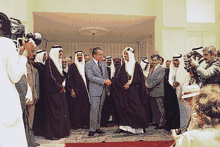Bisht (clothing)
A bisht (Arabic: بِشْت) or mishlaḥ (Arabic: مِشْلَح) or ʿabāʾ (Arabic: عَبَاء) is a traditional men’s cloak popular in the Arab world.[1] It is a flowing outer cloak worn over a thawb. It is usually black, brown, beige, cream or grey in colour. It is usually worn by secular officials or clergy. It is a status garment, associated with royalty, religious position, wealth, and ceremonial occasions.[2] A bisht is usually worn for prestige on special occasions such as weddings, or festivals such as Eid, or for Jumʿah prayers or funerals. In Iraq it is worn by tribal chiefs. The bisht is also worn by East African nobility, including tribal chiefs, kings, and imams, over a kanzu or tunic.

Etymology
The triliteral root of Bisht is widely used in Semetic Languages, including Arabic, and a theory is that the word bisht is derived from Akkadian ‘bishtu’, meaning ‘nobility’ or ‘dignity’.[3] The alternate name of ʿabāʾ (Arabic: عَبَاء) is from the Arabic triliteral root ʿAyn-Bāʾ-Wāw, which relates to 'filling out'.
References
-
- "Traditional & modern: The Saudi man's bisht". 7 November 2012.
- Urbanarabian. "B – Sweater – Over Sized Sweater". Urbanarabian. Archived from the original on 2016-09-11. Retrieved 2016-05-23.
- Hannah (27 April 2011). "Saudi Arabian Bisht".
- "صانع بشوت الحكام وكبار الشخصيات "البراهيم" لـ"الأحساء نيوز":صنعت بشت الملك فهد وابنه – صحيفة الأحساء نيوز". www.hasanews.com.
- "الثقافة الشعبية". www.folkculturebh.org.
- "البشت في الخليج العربي". www.abuhaleeqa.net.
- ناصر حسين العبّودي (1987). الأزياء الشعبية الرجالية في دولة الإمارات وسلطنة عمان. مركز التراث الشعبي لدول الخليج العربية،. pp. 121, 127, 129.
- ناصر حسين العبّودي (1987). الازياء الشعبية الرجالية في دولة الامارات وسلطنة عمان. pp. 121, 127, 129.
- http://dar.bibalex.org/webpages/mainpage.jsf?PID=DAF-Job:57506
- "كتاب الازياء الشعبية الرجالية في دولة الإمارات وسلطنة عمان". التبراة : عالم الكتب.
- http://www.raya.com/File/Get/2e58845b-9cc2-428c-abd1-c56523208548
- Najlā Ismāʻīl al-ʻIzzī al-Wahhābī (2003). أزياء قطرية. جمعية الفن الإسلامي،. p. 12. ISBN 978-0-9544445-2-5.
- S. D. Goitein (1983). A Mediterranean Society: Daily life. University of California Press. pp. 464–. ISBN 978-0-520-04869-0.
- Abū al-Maḥāsin Yūsuf Ibn Taghrībirdī (1960). History of Egypt, 1382-1469 A.D.: 1382-1399 A.D. University of California Press. p. 108.
- Al-Mukhtar, Rima (7 November 2012). "Traditional & modern: The Saudi man's bisht". Arab News.
- Dr. Ali Fahmi khashim, Akkadian Arabic Dictionary Page 140